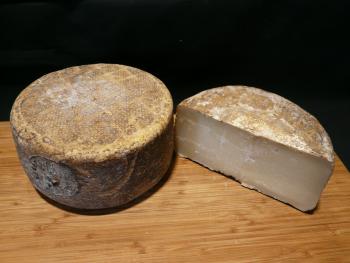Pecorino Toscano
- Producer
- Various
- Country
- Italy
- Region
- Tuscany, Umbria, Lazio
- Size
- 6-9 ins diameter, 3 ins high
- Weight
- 3-5lbs
- Website
- Milk
- Sheep
- Treatment
- Pasteurised
Raw - Classification
- Hard
- Rennet
- Animal
- Rind
- Natural

Here's a language lesson: The word for sheep in Italian is pecora—hence the name of this delicious sheep's milk cheese. There are many different types of Pecorino produced, particularly throughout southern and central Italy, where the landscape lends itself to herding sheep.
This iconic version hails from Tuscany. A traditional cheese, its name has been protected since 1986 with a DOP, which has united many local cheeses of similar production and appearance under one umbrella for quality control and marketing purposes.
Production of Pecorino Toscano can be from either raw or pasteurized milk, but it's always made with milk from animals who graze or are fed hay or dried grasses—no silage is permitted. Animal rennet is used to coagulate the milk (which takes 20 to 25 minutes) at a temperature of between 91.4°F and 100.4°F. Curds are cut to about the size of a pea, then re-heated to expel more whey before being put into forms and brined for about 12 hours. Cheeses are then matured in a cellar from three to six months.
Tasting Notes
Pecorino Toscano is sturdy and nutty with a hint of salt and underlying savory and sweet flavors that intensify with age. Although the wheels vary from maker to maker, they tend to be firm and intensely flavored, with a mildly peppery finish, becoming more savory and intense with age while retaining an underlying sweetness and mellow quality.
Pairings
We love shaving Pecorino Toscano over some rye pasta; its peppery and sweet fruity notes at once play to and round out rye’s slight bitterness, while elevating its grassy undertones. It's also great served alongside finnochiona, an Italian sausage made with fennel.



